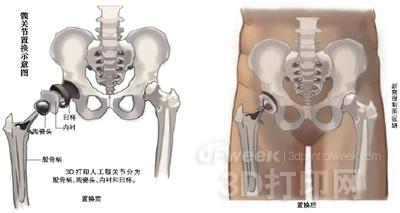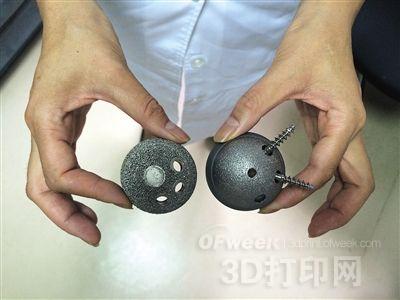Recently, China's first 3D printed orthopedic implant, 3D printed artificial hip joint products, was approved by the State Food and Drug Administration. With the aging of the social population structure, more and more patients lose their ability to work and self-care because of severe hip disease, and artificial hip replacement is needed.
Professor Zhang Ke, head of the orthopedic joint group at the Third Hospital of Peking University, pointed out that there were about 400,000 joint replacements in China in 2014, of which 3/4 were hip replacement surgery. According to the choice of domestic or imported artificial joints, the cost of an operation is about 50,000-100,000. Many families do not have surgery for economic reasons, or choose domestic prosthesis, but the surgical results are often not satisfactory. What kind of product is the 3D printed artificial hip joint and how is it made?

Only the cup is made by a 3D printer
In fact, from the appearance point of view, it is not much different from the existing artificial hip joint, it is also composed of four parts: cup, lining, ceramic head, femoral stem, wherein the lining is made of imported high-crossing Bi-polyethylene, the ceramic head is made in Germany, the stem is made in the UK, and only the cup is made by a 3D printer.
According to Cai Hong, deputy director of the Department of Orthopaedics, Peking University Third Hospital, the biggest feature of 3D printed artificial hip joints is the cup, which is made of the most advanced metal 3D printing technology . In the past, the cup was cast from titanium alloy. It was necessary to first chemicalize the titanium into a liquid to be cooled in a mold, and then make a micropore on the surface of the cup (the part that binds to the hip of the human body). coating. In this method, making a microporous coating and making a cup is a two-step process.

The 3D printed cup and its microporous surface are all in one go. The doctor transmits the data to the manufacturing company. The engineer then reconstructs the data into a three-dimensional shape through software analysis. According to the set shape, the electrode wire formed by the high pressure of 60,000 volts will be The titanium alloy powder previously placed in the forging box is stacked and forged, and finally a cup having a microporous structure on the surface is printed, and dozens of prints can be printed at a time.
Let the people use the same low-cost artificial hip joint
The application of 3D printing on metal has actually started more than 10 years ago, mainly in the aerospace field. In 2009, by chance, Professor Zhang Ke and Dr. Cai Hong saw the 3D printer that can be used for metal for the first time in an academic exchange in Sweden. Long-term clinical practice has made Zhang Ke sensitively aware of the application prospects of this equipment in the medical field. At that time, there was already a company in Italy that used 3D printers to produce medical devices. After returning to China, Zhang Ke’s idea was approved and supported by Liu Zhongjun, director of the Department of Orthopaedics, Peking University Third Hospital. Subsequently, Zhang Ke led the orthopedic joint team to develop the first 3D printed artificial hip joint product in China.
Before the development of this product, a set of domestic artificial hip joints needs about 20,000 yuan, the average imported artificial hip joints are about 30,000-70,000 yuan, and the high-end imported products are 60,000-80,000 yuan. This is just labor. The cost of the hip joint does not include other surgical expenses. "We have used a considerable number of imported products, and imported products account for 70% of the domestic market, especially in the North Shangguang area, which is more than 90%. This price is not affordable for everyone." Cai Hong pointed out that the recent In the 5-8 years, foreign companies are continually acquiring Chinese companies, and gradually form a market monopoly, resulting in higher and higher prices for artificial hip joints. As a doctor, the R&D team of 3D printed artificial hip joint products hopes that the domestic artificial hip joint can break the monopoly and compete with the low price of imported products, thus lowering the price of imported products.
Zhang Ke said that from the current cost of orthopedic surgery, 70% of the patients' money is used to buy imported materials, and the official use of 3D printed artificial hip joint products will greatly reduce the cost of medical treatment for patients. "Our product, the quality is absolutely not lower than the foreign artificial joints, but the domestic price is 1/2 or 2/3 of the import." Cai Hong said that the specific price has not been worked out, but the price is definitely lower than the imported products.
3D printed cups can reduce the occurrence of prosthesis loosening
In Cai Hong's office, there is another domestic artificial acetabular cup. This was taken out from the body of Wang Xiulan (a pseudonym) in Shandong province more than half a month ago. This acetabulum had been in Wang Xiulan's body for five years, but failed to improve her quality of life. Although the screw secures the cup to her hip bone, the bones and the acetabulum can't grow together. The screws that fix the cup are gradually loosened, and the cup rubs against the contact surface. The pain caused by friction is tortured. Wang Xiulan was in the 5th year. Until the femoral prosthesis fracture occurred more than half a month ago, Wang Xiulan went to the hospital for a revision surgery.
"Only when the bone grows into the cup, it can be permanently fixed. Otherwise, it can only be temporarily fixed." It is Cai Hong who performed the revision surgery for Wang Xiulan. For economic reasons, Wang Xiulan chose a not so good artificial hip joint and spent about 40,000 yuan on artificial hip replacement. But because the cup has worn out her bones, the revision surgery requires a more complicated prosthesis. To this end, she also needs to pay about 100,000 yuan for surgery.
The domestic artificial hip joint taken from Wang Xiulan's body, the surface of the cup is relatively smooth, and the 3D printed cup surface is covered with irregular tiny holes, which is very rough. Zhang Ke said that this microporous structure is similar to the structure of the human cancellous bone trabecular bone, which can increase the friction of the acetabular cup and obtain immediate stability after surgery. It is also beneficial between the patient's bone and the metal cup. Rapid osseointegration, that is, bone can quickly grow into the metal acetabular cup, reduce the occurrence of prosthesis loosening, and provide a reconstructed acetabular cup that is more suitable for individual needs in patients with severe acetabular bone defects. To solve the clinical complex renovation problems.
Up to now, dozens of patients have undergone 3D printed artificial hip surgery. "All clinical results are very good, and there is no evidence of loosening, displacement, or failure of the prosthesis." Cai Hong said.
â– Hot spots
No problem after 20 years of use
Q: What diseases can 3D print artificial hip joints be used for?
Cai Hong: 3D printed artificial hip joints can be used in patients with end-stage hip disease, including femoral head necrosis, dysplasia, fractures, and osteoarthritis.
Q: How long does this artificial hip joint last?
Cai Hong: In terms of international use standards, at least 90% of people can use it for more than 10 years, and 80% of people can use it for more than 20 years. 3D printing artificial hip joints should be no problem for about 20 years.
â– Experts look forward to
Personalized customization should be quickly approved
The reporter learned from the North Hospital Third Hospital that in addition to the approved 3D printed artificial hip joints, there are other artificial bone and joint products based on 3D printing, such as artificial vertebral bodies and artificial pivots. At present, the artificial vertebral body has entered the stage of clinical review; the artificial pivot is still in the clinical trial stage.
Although China has developed 3D printed artificial hip joints earlier than some countries, Cai Hong said that because of the need for clinical verification, US related products have been approved for production in China, and similar orthopedic plants in Korea and Germany have already been listed. The registration approval process for 3D printed implants in China is relatively long. “The artificial hip joints we developed were clinically researched and finally approved, and it took about 40 months.†Cai Hong hopes that this process can be shortened.
"Science and technology innovation needs fast track and regulatory support." As a representative of the National People's Congress, Liu Zhongjun also called for the registration approval process for 3D printed implants at this year's National Conference. I don't want China to just start in this field. Early in the morning, but caught up in the evening."
In addition, the individualized customization of 3D printed orthopedic implants is still constrained. Cai Hong said with regret that at present, mass production can only be carried out according to the model approved for registration, and individualized customization cannot be achieved. Some patients' needs cannot be met. Personalized customization also requires the support of relevant laws and regulations. As the first approved 3D printed orthopedic implant in China, the 3D printed artificial hip joint actually promoted the construction of the legal and regulatory system for 3D printing products in the drug supervision system during the registration process. "It is said that at the end of the year, a draft or draft of the regulations on individualized customized medical devices will be introduced."
Pneumonia Mask,Corona Virus Mask,Protective Masks For Virus,Coronavirus Pneumonia Face Mask
ShanDong YongFang Sanitary Products Co.,Ltd , https://www.sdyongfang.com